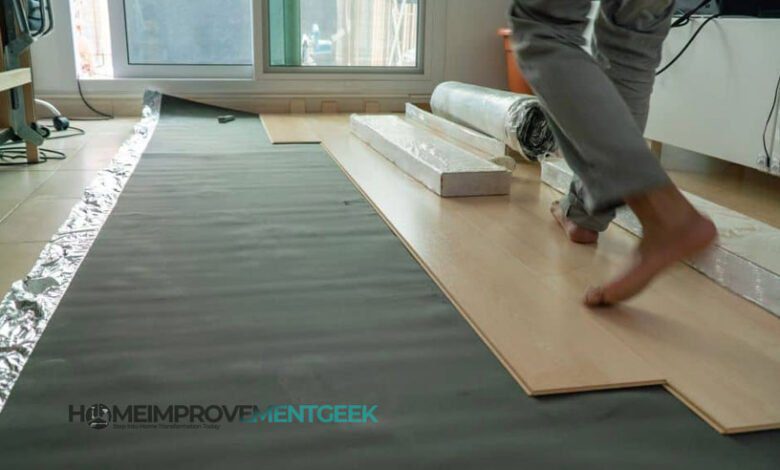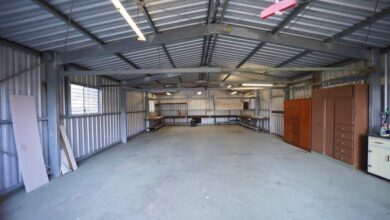Should You Use Roofing Felt as Underlayment for Vinyl Flooring?

Installing new vinyl flooring can be an exciting project that transforms the look and feel of a room. But what lies beneath that stylish new floor is just as important as the visible surface layer. The underlayment beneath vinyl flooring plays a crucial role in impact resistance, moisture protection, and sound absorption. With so much riding on the underlayment layer, it’s critical to use the right material. But can you get away with using roofing felt as underlayment for vinyl plank flooring instead?
This article will look at the purpose of vinyl flooring underlayment, whether roofing felt is suitable for the job, important differences between the two materials, recommendations for proper vinyl flooring underlayment, and cost-effective underlayment options. Read on to find out whether roofing felt makes the grade as vinyl plank flooring underlayment and see our ultimate recommendation on the topic.
Why Underlayment Matters in Vinyl Flooring
Before diving into whether roofing felt is an appropriate choice, it’s helpful to understand why the underlayment layer is so important with vinyl flooring. There are three major reasons the underlayment plays a critical role:
- Cushioning: Quality vinyl underlayment provides a cushioned layer to absorb impacts. This protects the vinyl planks from denting, extends the floor’s lifespan, and offers comfortable underfoot padding.
- Sound isolation: Underlayment provides sound dampening and absorption which reduces noise transfer between floors. This is especially beneficial for multi-level homes.
- Moisture barrier: Underlayments for vinyl flooring incorporate an impervious moisture barrier film to prevent moisture migration into the flooring. This protects vinyl plank flooring from warping or water damage issues.
With those key functions in mind, using the right underlayment material beneath your vinyl floor is non-negotiable. Next, let’s look at the specifics of roofing felt to see how it stacks up.
What Is Roofing Felt Underlayment?
Before assessing whether it makes for suitable vinyl plank underlayment, it helps to understand exactly what roofing felt is. Roofing felt is a moisture barrier material used beneath shingles and other roof coverings. There are a few main types:
Asphalt-Saturated Organic Felt
- The most common traditional roofing felt
- Made from recycled paper or cardboard fibers saturated with asphalt
- Provides a water-resistant base layer on roofs
- Affordable option
Rubberized Asphalt Underlayment
- Incorporates a thermoplastic elastomer blend with asphalt
- More durable and flexible than saturated felt
- Offers greater water resistance
- More expensive than organic asphalt felt
Synthetic Underlayment
- Made from woven or non-woven synthetic fibers
- Coated or infused with materials for water resistance
- The lightest roofing underlayment option
- More tear-resistant than traditional felts
The main purposes of roofing underlayments are preventing moisture ingress and providing a protective base layer beneath roofing materials. With the function of roofing felt covered, let’s look at how vinyl flooring underlayments compare.
Key Purposes of Vinyl Flooring Underlayment
As touched on earlier, quality vinyl plank flooring underlayments serve several important purposes beyond just moisture protection:
Cushioning and Comfort
Vinyl underlayment should provide a cushioned layer between the subfloor and vinyl flooring for:
- Shock/impact absorption
- Noise reduction
- Underfoot comfort
Only underlayments with cushioning can properly achieve these goals.
Sound Insulation
In addition to cushioning, vinyl underlayments need specialized construction to dampen sound transmission. This includes:
- A mixture of fabrics and films
- Attached moisture barrier film
- Adhesive bead barriers
Together these components block noise from traveling between building levels.
Moisture & Vapor Barrier
Like roofing felt, vinyl underlayment also incorporates a moisture barrier film. But vinyl moisture barriers need:
- High density and thickness
- Ability to seal seams/perimeters
- Moisture-proof adhesive strips
This prevents moisture damage to the vinyl flooring itself.
As you can see, vinyl plank flooring underlayment has specialized requirements beyond just waterproofing. Next, let’s see how roofing felt measures up.
Can You Use Roofing Felt as Underlayment for Vinyl Planks?
With a grasp on the purposes and requirements of vinyl plank flooring underlayment, the question remains — can you substitute roofing felt in place of vinyl underlayment?
You can physically install vinyl flooring over roofing felt. But there are good reasons to avoid using roofing felt as vinyl plank underlayment:
Lack of Cushioning
The biggest issue with using roofing felt under vinyl planks is it provides zero cushioning or sound dampening. Roofing felt lies flat to create a water-shedding layer on roofs. Without cushioning, vinyl flooring installed over roofing felt would have poor shock absorption. Any impacts would transfer directly to the rigid vinyl planks — easily causing dents and fractures over time. Sound isolation would be non-existent as well, with noise easily traveling between building levels.
Potential Odor Issues
There are also potential odor issues to consider with roofing felt. Petroleum-based saturated felts and rubberized asphalt felts have an inherent asphalt odor. This smell often lingers after application. The attic-like odor could end up permeating into the vinyl flooring installed over top.
Shortcuts Moisture Barrier Performance
Additionally, relying solely on roofing felt leaves vinyl flooring vulnerable to moisture damage. Roofing felts are not designed to seal tightly around perimeter edges. Nor do they incorporate adhesive strips for an impenetrable moisture seal like vinyl underlayments. Moisture could still migrate under vinyl flooring installed over roofing felt alone.
While it is possible from a technical standpoint to use roofing felt under vinyl planks, performance would be severely lacking. For proper moisture barriers, sound deadening, and shock absorption — purpose-designed vinyl underlayment is recommended.
Key Differences Between Roofing Underlayment and Vinyl Underlayment
To summarize, there are a few notable ways that roofing underlayments differ from products designed for beneath vinyl flooring:
| Roofing Felt/Underlayment | Vinyl Flooring Underlayment |
|---|---|
| Flat, sheet material | Textured or cushioned construction |
| Asphalt saturated paper or synthetic fibers | Cushioning foam, films, protective top layers |
| Provides water resistance only | Waterproof + moisture-proof barrier + air + vapor resistance |
| Loosely applied in sheets | Tight perimeter seals + adhesive moisture strips |
| No cushioning or padding | Shock/impact absorption |
| No sound dampening | Purpose-built sound barrier layers |
As shown above, the two materials have vastly different constructions and functional capabilities. Roofing underlayment lacks the cushioning, vapor barriers, and noise insulation vital in quality vinyl plank underlayments.
Why Proper Vinyl Underlayment Matters
With roofing felt falling short as vinyl underlayment, let’s revisit why using the right underlayment is so critical in the first place:
Prevents Premature Flooring Failure
Improper underlayment shortens the serviceable life of vinyl plank flooring. Lacking cushioning and sound insulation, floors see accelerated wear from impact damage and noise transmittance through building structures. This leads to damage like fractures, loosening, and water ingress that prompt early replacement.
Provides Comfort Underfoot
Cushioning is the primary contributor to comfortable vinyl flooring. Underlayment provides thickness and padding that makes prolonged standing easier, while also offering better insulation from cold subfloors. Roofing felt offers no comfort or warm feel.
Upholds Performance Claims & Standards
Vinyl plank performance testing and ratings rely on proper underlayment use. Installing over non-approved materials often voids crucial usage guidelines, warranties, and other protections against early failure.
Minimizes Noise Transfer Between Floors
With buildings getting taller and living spaces moving upward, minimizing between-floor noise is crucial. Quality vinyl plank underlayment achieves sound ratings as high as IIC 72 and STC 67 — blocking much of the noise between stacked units in multi-floor buildings. Roofing felt has no sound-dampening abilities.
Safeguards Interior Environments
Using improper underlayment materials introduces potential off-gassing issues into living spaces as well. Roofing felt carries an asphalt odor that permeates without a sealing top layer barrier. Vinyl underlayments use safe, non-toxic cushioning materials and impermeable films instead.
For all these reasons, using roofing felt under vinyl plank flooring falls short. While the roofing material acts as a moisture barrier, it lacks the cushioning, sound insulation, odor blocking, and perimeter sealing vital to vinyl underlayment performance. Simply said, roofing felt misses the multilayered construction and functionality demands that quality vinyl plank flooring requires.
Next, let’s look at some recommended alternatives that offer cost-effective solutions without the performance compromises of roofing felt.
Quality, Affordable Alternatives to Vinyl Flooring Underlayment
Instead of roofing felt, there are several budget-friendly underlayment products suitable for use beneath vinyl plank flooring:
1. Foam Cushion Underlayment
- Closed-cell cushion foam
- 1-5mm thickness options
- Cost range: $0.10 – $0.30 psf
Foam cushion provides basic shock absorption and adds little height to floor assemblies. Look for density of at least 2 PCF.
2. Frothed Foam Underlayment
- Injected air pockets in cushion foam
- Enhanced comfort and compression
- Cost range: $0.15 – $0.45 psf
Frothed (or reticulated) foam improves stability and durability over standard foam cushion.
3. EPS Bead Foam Underlayments
- Expanded polystyrene bead foam
- High resiliency and support
- Cost range: $0.30 – $0.50 psf
EPS foam beads offer excellent moisture resistance and vibration dampening — at costs comparable to basic foam.
4. CORK Underlayment
- Natural renewable harvested bark
- Antimicrobial and mold-resistant
- Cost range: $0.30 – $0.80 psf
Cork provides environmental benefits alongside durability, structure, and comfort enhancing abilities.
These alternative vinyl underlayments meet key requirements like moisture barriers, perimeter seals, and adhesive strips often lacking in roofing felt applications. Without breaking budget, quality underlayments like these improve flooring performance while avoiding unnecessary risks.
Proper Installation of Vinyl Underlayment
Whichever underlayment you choose, correct installation is also essential for vinyl flooring success. Here is an overview of best practices when applying vinyl plank underlayment:
Step 1: Subfloor Prep
- Level uneven surfaces
- Fill cracks/gaps over 1/4”
- Secure loose panels/boards
Prepping the subfloor gives the underlayment a smooth surface to adhere to.
Step 2: Sweep and Vacuum
- Remove all dirt and debris
- Eliminate bumps or particle buildup
Proper cleaning lets the underlayment bond flush across the floor area without high points interrupting vinyl plank contact.
Step 3: Roll Out Underlayment
- Unroll material parallel to vinyl plank layout
- Butt edges tight without compression
- Run perpendicular only where necessary
Laying the underlayment in the same direction maximizes adhesive and sealing strip contact across plank seams.
Step 4: Tape Perimeters and Seams
- Use moisture-proof vinyl underlayment tape
- Seal all joints, perimeter edges, pillars, etc.
Carefully tape all seams and edges for an impenetrable moisture barrier protecting the vinyl planks.
Step 5: Install Vinyl Planks
- Follow vinyl flooring manufacturer guidelines
- Use recommended adhesives if called for
- Avoid walking excessively on installed underlayment
With the underlayment prepped, vinyl flooring installation can begin for a healthy and durable end product.
Conclusion
To answer the original question — no, roofing felt on its own does not meet vinyl plank flooring underlayment requirements. While roofing felt does provide a degree of moisture protection, it lacks necessary cushioning, sound dampening, and perimeter seals vital to vinyl floor performance and longevity. On the other hand, quality vinyl underlayments incorporate composite constructions to meet these needs at various price points. For a balance of affordability and functionality beneath vinyl planks, materials like foam cushion, EPS bead foam, frothed foam, or cork provide cost-effective alternatives without the downsides of roofing felt alone. By skipping roofing felt as a vinyl flooring shortcut, and instead using proper vinyl underlayments installed correctly, you can protect the beauty and enjoyment of vinyl plank floors for years to come.




